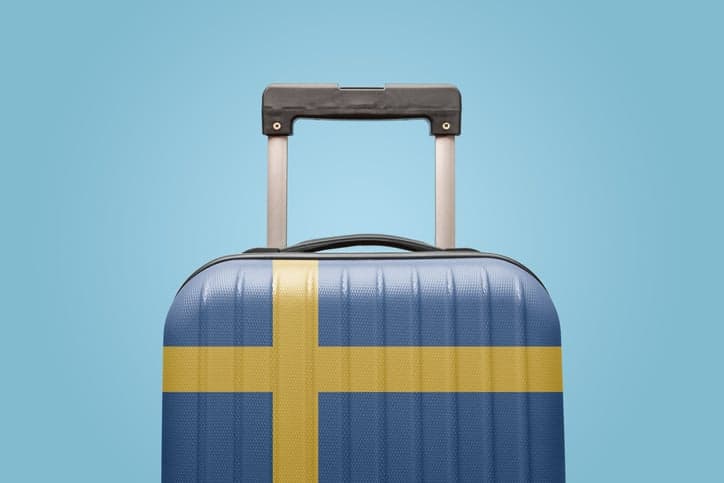Five steps to settle easily in Sweden
Moving country - even to Sweden, with all its joys - is tough. There is so much to organize and resolve once you're on the ground. Following these five steps, however, will make your transition much more comfortable, and leave more time for you to enjoy your new home.

Yes, that means learning to love meatballs (don’t worry, vegetarians: plant-based varieties abound!) and doing your best to believe there’s no such thing as bad weather, only bad clothes. No, really, stop laughing … your Swedish hosts insist!
But it also means ploughing through a host of humdrum tasks. The Local has partnered with Akademikernas a-kassa, Sweden’s leading unemployment insurance fund, to bring you five essential steps you should take to get your Swedish life on track.
1. Priority one: your personal number
First, you obviously want to ensure you have the right to remain in Sweden and get the documentation to prove it. If you plan to stay for a year or more, you’ll almost certainly have to be listed as a resident in the Swedish Population Register.
This means you must notify Skatteverket (the Swedish Tax Agency) and visit one of its state service centres with certain documents (use its Moving to Sweden e-service to find out which ones you personally will need). If you're a citizen of a non-EU or non-EEA country, you must get a residence permit from Migrationsverket (the Swedish Migration Agency) before applying to the Tax Agency.
Once you're listed in the Population Register, you’ll get a personnummer (personal identity number) that is yours for life. This number opens many doors in Swedish society – allowing you to identify yourself with government agencies, healthcare providers and private companies – so learn it by heart! You can also now apply for a personal ID card with your photo and personnummer.
Grattis! (congratulations!) You’ve taken your first big step to settling in Sweden. Looking ahead, you may want to consider the various routes towards obtaining permanent residence status.
You should also be aware that under the new Swedish government, which took power in October 2022, various immigration rules are under review. One plan, for example, will raise the minimum salary for granting work permits to non-EU citizens.
2. Sign up for social insurance
As soon as you’ve got your personnummer, it’s time to turn your attention to Försäkringskassan. Yes, unfortunately it’s even more of a mouthful than Skatteverket! But don’t let the name put you off.
This is the Swedish Social Insurance Agency, which means it’s responsible for many of the generous benefits for which Sweden is well-known internationally.
You must register with Försäkringskassan to be eligible for föräldrapenning (parental leave benefit), sjukpenning (sick leave benefit), and tandvårdsstöd (dental care support). This is also true for bostadsbidrag (housing allowance), which is available mainly to families or young people needing help with their rent.
It’s easy to register and you’ll find a wealth of information on the agency’s pages in English to help you understand which benefits you may be able to claim.
 Got your personal number? Great! But are you ready to 'go native' by exercising in all weathers? Photo: Getty Images
Got your personal number? Great! But are you ready to 'go native' by exercising in all weathers? Photo: Getty Images3. Get clued up on Money, Money, Money (and BankID)
Personal finance in Sweden may be very different from your home country. Cash is definitely not king here, for instance. Sweden is one of the world’s most cashless societies and you can go years (yes, years!) without handling a bank note.
This is because Sweden is one of the world’s most digitally advanced countries, with many shops and eateries only accepting payment by card or mobile solutions like Swish (which is used by almost 80 percent of the population!)
Getting a local bank account is extremely easy to do online with a personal number. Opening one before you have a personal number is slower but still possible at many banks if you visit in person with sufficient documentation.
Last but not least, when you become a customer with one of ten banks, you’ll be able to get BankID, so long as you also have a personal number. This makes the process of proving your identity in digital environments incredibly quick, easy and secure.
Most people choose Mobile BankID, so you can use it on your smartphone to make online payments or digital signatures through facial recognition, your fingerprint or a personal security code. No wonder, it’s used 200 times per second!
4. Start your new job or job search
If you moved to Sweden to start a new job, bra jobbat! That’s ‘good work’ or simply ‘well done’.The Swedish labour market isn’t considered the easiest for newcomers to break into, so having a job to start immediately is a blessing.
What if you moved from abroad to be with a Swedish partner, or to join a partner who got an exciting offer, and now want to look for work yourself? One of your first ports of call should be Arbetsförmedlingen (the Swedish Public Employment Service).
Register, create a profile, and get searching for opportunities. If you live in another EU/EEA country or Switzerland, EURES may be able to help you with information and guidance on finding work in Sweden.
 Looking for work in Sweden? Signing up with Arbetsförmedlingen should be one of your first steps. Photo: Getty Images
Looking for work in Sweden? Signing up with Arbetsförmedlingen should be one of your first steps. Photo: Getty ImagesLooking only for English language jobs? Don’t despair. As you’d expect in a country with such a high standard of English, there are plenty of such jobs in cities such as Stockholm, Gothenburg and Malmö – many of them on The Local’s jobs pages.
Want to move to Sweden as a self-employed person? That’s also possible but you’ll have to first apply for a work permit if you’re not a citizen of an EU or EEA country.
5. Protect your income
There’s so much to think about when moving abroad, especially if you’re also entering a new job. You’re hardly to blame, therefore, if you’re unfamiliar with Sweden’s unemployment insurance system.
But understanding the basics could help you put your new life on a more secure footing. While unemployment insurance is compulsory in most of the EU and the UK, it’s partially voluntary in Sweden and that’s where a-kassas like Akademikernas a-kassa come in.
Only by joining an a-kassa (or unemployment fund) will you be entitled to the full income insurance benefits available in Sweden, rather than the limited state provision.
Akademikernas a-kassa, Sweden’s leading unemployment fund, is open to university graduates who are employed or self-employed, as well as students, and costs just 130 Swedish kronor per month. Members can receive up to 80 percent of their previous salary when between jobs. Want to know one more Swedish secret? You can even apply without BankID or a personal number!
This content was paid for by an advertiser and produced by The Local's Creative Studio.

Join the conversation in our comments section below. Share your own views and experience and if you have a question or suggestion for our journalists then email us at [email protected].
Please keep comments civil, constructive and on topic – and make sure to read our terms of use before getting involved.
Please log in here to leave a comment.